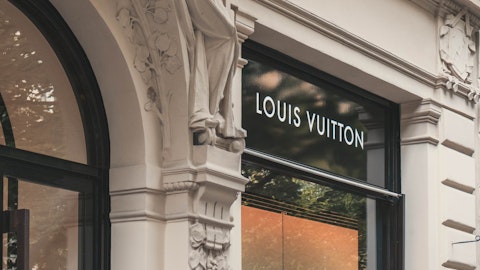Operator: Our next question comes from Adrienne Yih with Barclays.
Adrienne Yih: Great. Richard, this is sort of more philosophical question given you’ve only been there 3 days — a year and then 3 days. So your tenure at Mattel was sort of similar in concept sort of reinvigorate sort of the core brands, restore growth and restore the position sort of as an industry leader. So I guess my question is, oftentimes, when you have a company that’s been struggling, the creative team and all those assets get very safe, right? So they become very risk averse. And I’m just wondering, how do you create a culture of greater risk-taking and innovation such that, that creativity can kind of come to the forefront?
Richard Dickson: It’s a great question. There are a lot of parallels with my experience at Mattel and Gap Inc.’s business across many levels. And I’m here to architect and orchestrate ultimately to lead. And the parallel construction of where Mattel was and where Gap is, is very familiar. Great assets great talent, a moment where, to some extent, a lot of self-inflicted challenges, some within our control and some ultimately impacting our business and our industry. And ultimately, a phase that we are going to go through, which is really about unlocking the value of our brands through reigniting a creative culture, the balance of fundamental and/or fiscal responsibility and operational rigor. While you are driving a design-centric and creative culture is the art and science of the leadership that you need to have in this business.
It is a very familiar language. It’s actually a very familiar model. And ultimately, you’ve got to be able to take swings that are calculated, test, roll, learn and scale and accelerate very, very quickly. That is a muscle that we will begin to exercise and strengthen with the experience that I bring in the context of that type of leadership, I believe that that’s going to add value very, very quickly. This is an organization that is really excited to unlock and reignite, if you will, creativity. And so I feel incredibly fortunate to be inheriting a business that, from a transformational perspective, has come through, if you will, a very heavy lift and is now delivering, if you will, a fertile ground for a design-led culture, creativity that ultimately will show up for consumers and the ability for us to make brands that matter, matter more.
Adrienne Yih: That’s super helpful. Katrina, one quick one — sorry, did you talk about shrink? When do you take your physicals? I think it’s midyear, but I may be wrong. And is there anything to call out there of note?
Katrina O’Connell : Yes. There’s nothing notable to call out from us on shrink. We do full counts once a year in the early part of the year, first quarter. We do partials in the second half of the year. And as of now, our shrink remains below pre-pandemic levels, and there’s really nothing to call out. So shrink is so far for us not anything of note.
Operator: Our next question comes from Dana Telsey with Telsey Group.
Dana Telsey : Welcome, Richard. Just following, Richard, in terms of some of the thoughts to what you’ve done in the past. I’ve read some of the articles about how you put together the thoughts on brand relevance of 4 points. Why do we exist design-led innovation, culturally relevant and execute with excellence. How do you look at those initiatives or those topics in comparison to Gap and your initial thoughts on reinventing and rearchitecting the business model in any way. And then, Katrina, I just wanted to follow up on, as you think about 2024 and planning, how are you thinking about inventories for the back half of the year and into next year?
Richard Dickson: Thank you for the study of my background and playbook at Mattel. My experience in turning brands around accelerating performance, it goes beyond the development of a playbook, but really rallying teams to deliver on a plan, ensuring operational rigor and enabling a culture to execute with excellence. And the context of that methodology, when you look at Gap brands, these are beloved brands. They have a real connection with consumers, and we need to reignite that connection. I’m passionate about motivating teams to uncover what made a brand or a company iconic and special in the first place and then working together to reinvigorate them to new relevance. So the familiarities in the context of the work and legacy brands revitalization methodologies are familiar and similar.
That being said, the playbook that we will reveal that will be the strength and the consideration set to reignite the Gap portfolio will be one that we’ve collectively work on as a team as I listen, learn, spend time with our stores, our headquarters, DC, partners and really start to understand ultimately what will be the Gap playbook that will deliver ultimately to our consumers, our people and our shareholders, and we’ll be back shortly to be able to share all of that.
Katrina O’Connell : And then, Dana, on inventory, we do expect that third quarter ending inventory will be very similar to the first half trends. And overall, more to come as we head into next year, but we expect to be running more and more on leaner inventory with receipts left opened so that we can be more responsive to consumer demand closer in. And a lot of the transformational activity that we’re working on is not only just reinstating the responsive levers that we’ve had, but working closer with our vendor base to make sure that we have the right materials, the right logic with our vendors to be closer to the consumer. So all of that helps us have leaner inventories and be more dynamic. So more to come on what those levels are going forward.
Operator: Our last question comes from the line of Brooke Roach with Goldman Sachs.



